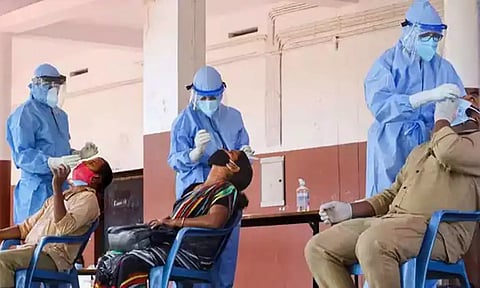

Data released by the Union Health Ministry on Thursday said that India recorded 702 fresh cases of COVID-19, over the past 24 hours. The active caseload stood at 4,097. The emergence of sub-variant JN 1 has been giving health officials bouts of anxiety, considering New Delhi reported its first case of JN 1 infection on Wednesday. Six fatalities were reported in the last 24 hours — two in Maharashtra and one each in Delhi, Karnataka, Kerala and West Bengal. The rise in infections could be attributed to JN 1 sub-variant, with Kerala and Karnataka remaining the epicentres of the spike.
Since the outbreak in January 2020, India’s COVID-19 count has breached 4.5 crore, while the death toll has hit 5.33 lakh. So, should the JN 1 sub-variant set off alarm bells? We might need some context to make sense of this. The JN 1 is a sub-lineage of BA 2.86 or the Pirola sub-variant of Omicron, and it has been declared as a variant of interest by the WHO. It was first detected in Luxembourg this August, after which the contagion was reported in England, Iceland, France and the US — nations where genomic surveillance is active. The sub-variant appears to be more infective, and potentially more immune evasive than the Pirola variant, but not more virulent. Experts have suggested that this sub-variant could outcompete and displace the XBB lineage, which happens to be the currently dominant one across the world.
The emergence of the sub-variant is being reported at a time when antibody levels in previously infected or immunised individuals seems to have waned. Winter is also known for being conducive to the spread of respiratory viruses, especially as human congregations tend to peak during the holiday season. To top it off, this is a period when native immunity levels tend to drop, as our exposure to ultraviolet light gets limited, thanks to the earth tilting away from the sun. It might seem like a perfect recipe for contagion — no prizes for recalling that the pandemic had also kicked off during peak winter of 2019.
So, how concerned should we be, as we careen headlong into a new year. Virologists opine that there is a case to be made in favour of being cautious, but there is no reason to hyperventilate. Doctors have recommended that people with low or suppressed immunity, elderly individuals, and those with severe comorbidities should protect themselves with masks, when interacting with other individuals, and should preferably avoid crowds. Senior health officials of the government have also remarked that there has been no decision yet to recommend the administration of a fourth vaccine booster dose, as none of the Omicron sub-variants have been associated with severe disease or hospitalisation.
The Health Ministry has instructed states to increase testing and submit positive samples for further probe. This May, after a sustained decline in the trajectory of COVID cases, hospitalisations, and deaths, coupled with high levels of population immunity to SARS-CoV-2, WHO declared COVID-19 no longer constituted a public health emergency of global concern. For all practical purposes, COVID is now part of our ecosystem, and will keep undergoing mutations, resulting in period surges and slumps. It’s something we will have to contend with, whether we like it or not.